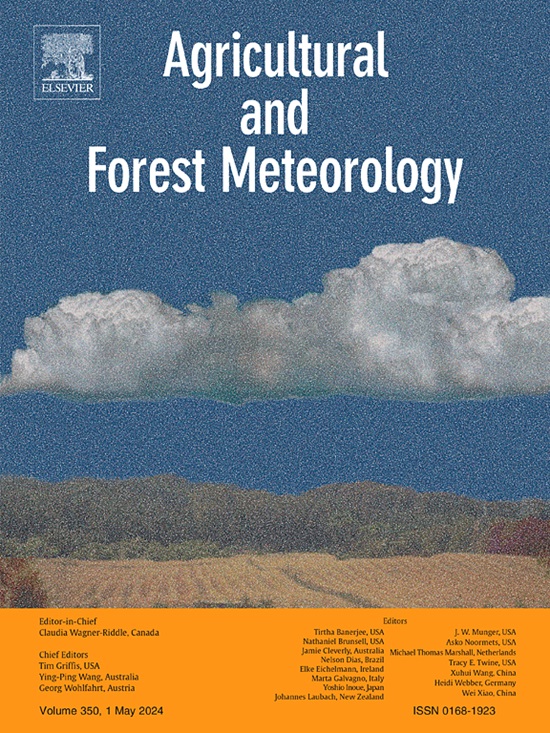通量方差相似(FVS)方法在山地云雾林蒸散发分区中的挑战与局限性
IF 5.6
1区 农林科学
Q1 AGRONOMY
引用次数: 0
摘要
对蒸散发组分的划分对于深入了解农业和森林生态系统中的能量、水和碳循环至关重要。本研究将通量方差相似度(FVS)方法应用于台湾祁兰山云雾林和连华枝林的蒸散量分析,该方法因其能够分离涡动相关数据集的蒸散量而受到称赞。然而,利用FVS方法在蓝山云雾森林中发现了一个偏早的蒸腾峰值,与群落土地模式蒸腾日循环、观测到的液流速度和净辐射不一致。这种偏倚归因于比湿度的迅速增加,这是由山谷风产生的额外水汽源引起的。这一因素违背了FVS方法的假设,导致描述净初级产量(NPP)的CO2通量提早达到峰值。此外,从下午到晚上的高相对湿度条件对叶级水分利用效率有较大的贡献,这主要是由于细胞间和周围水汽浓度之间的梯度很小。净初级生产量和水分利用效率的早期峰值使估算蒸腾的日变化过程发生偏斜。此外,早晨大量的冠层蒸发量和高相对湿度时期水分利用效率的不确定性导致了蒸腾值的总体不确定性。因此,由于固有的不确定性,在类似于志兰山云雾林的环境中应用FVS方法需要谨慎。我们的研究强调了探索不同蒸散分配技术的必要性,特别是在像山区这样的地形中,日水汽积累迅速,并且始终处于高相对湿度的地方。本文章由计算机程序翻译,如有差异,请以英文原文为准。
Challenges and limitations of applying the flux variance similarity (FVS) method to partition evapotranspiration in a montane cloud forest
Partitioning evapotranspiration components is crucial for an in-depth understanding of energy, water, and carbon cycles in agricultural and forest ecosystems. In this study, the Flux Variance Similarity (FVS) method, lauded for its capability to segregate eddy covariance datasets' evapotranspiration, was applied in Taiwan's Chi-Lan montane cloud forest and the Lien-Hua-Chih forest. However, we discovered a biased early peak of transpiration using the FVS method in the Chi-Lan montane cloud forest that did not align with the diurnal cycle of transpiration obtained from the Community Land Model, observed sap flow velocity, and net radiation. This bias is attributed to the rapid increase in specific humidity, caused by additional water vapor sources from valley wind. This factor violates the FVS method's assumptions and leads to an early peak in CO2 fluxes describing the net primary production (NPP). Furthermore, the high relative humidity conditions from afternoon to evening contribute to a larger magnitude of leaf-level water use efficiency, primarily due to minimal gradients between intercellular and ambient water vapor concentrations. The early peak of net primary production and water use efficiency skew the diurnal course of estimated transpiration. Additionally, the substantial canopy evaporation in the morning and the uncertainty in water use efficiency during periods of high relative humidity contribute to the overall uncertainty in transpiration values. Consequently, the application of the FVS method in environments akin to the Chi-Lan montane cloud forest warrants caution due to the intrinsic uncertainty. Our research emphasizes the imperative to explore different evapotranspiration partitioning techniques, especially in topographies like mountainous regions where diurnal water vapor accumulation is swift and places that are consistently subjected to high relative humidity.
求助全文
通过发布文献求助,成功后即可免费获取论文全文。
去求助
来源期刊
CiteScore
10.30
自引率
9.70%
发文量
415
审稿时长
69 days
期刊介绍:
Agricultural and Forest Meteorology is an international journal for the publication of original articles and reviews on the inter-relationship between meteorology, agriculture, forestry, and natural ecosystems. Emphasis is on basic and applied scientific research relevant to practical problems in the field of plant and soil sciences, ecology and biogeochemistry as affected by weather as well as climate variability and change. Theoretical models should be tested against experimental data. Articles must appeal to an international audience. Special issues devoted to single topics are also published.
Typical topics include canopy micrometeorology (e.g. canopy radiation transfer, turbulence near the ground, evapotranspiration, energy balance, fluxes of trace gases), micrometeorological instrumentation (e.g., sensors for trace gases, flux measurement instruments, radiation measurement techniques), aerobiology (e.g. the dispersion of pollen, spores, insects and pesticides), biometeorology (e.g. the effect of weather and climate on plant distribution, crop yield, water-use efficiency, and plant phenology), forest-fire/weather interactions, and feedbacks from vegetation to weather and the climate system.

 求助内容:
求助内容: 应助结果提醒方式:
应助结果提醒方式:


